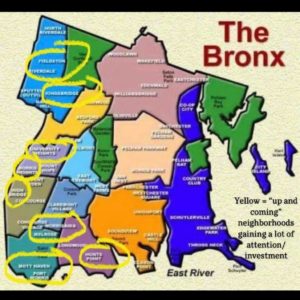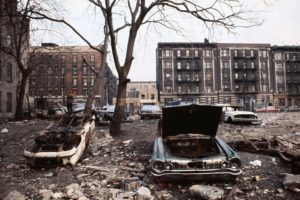The Downfall to “Up and Coming” neighborhoods: a South Bronx Tale of Gentrification

Imagine shows Bronx neighborhoods deemed as “up and coming” and shows that many are located in the South Bronx
Countless new buildings and establishments have seemingly appeared from thin air in The South Bronx, leaving the neighborhood of Mott Haven amidst a crossfire of demolition and rebuilding. As a result, once barren lots and abandoned lands are now claimed by highrise condominiums and brand-new overconfident retailers. Upon visiting this “new and improved” neighborhood, patrons awe in the glory of an enhanced borough, hypnotized by sparkling new sidewalks and lavish decorative murals. Nevertheless, locals who have walked these sidewalks dirtied and brittle, rain and snow, cannot be fooled by the pretty picture painted over their land. Although the South Bronx was in desperate need of a facelift, the rising prices and displacement of existing communities indicates that the boroughs reconstruction threatens the culture and authenticity of its neighborhoods. In short, gentrification is at the doorsteps of Bronx natives and it is disguised as renovation.
Rebuilding of the South Bronx was well overdue and is not a new concept for the borough. In fact, formal propositions for renovation began developing over thirty years ago in the mid 1980s, over a decade after The Bronx was burning. Battle For The Bronx: Neighborhood Revitalization In a Gentrifying City, by Catherine Claire Guimond, provides historical context regarding the reconstruction of the borough. From the dramatic abandonment of The South Bronx in the 1970’s to its sudden rise in interest, Guimond explores the long fight for survival these neighborhoods have endured. In her book, Guidmond speaks of the first efforts to reform the borough. She writes, “in the 1970s, residents began taking over abandoned buildings and renovating them themselves … In the midst of crisis and devastation, South Bronx residents seized control of buildings no one else wanted and made them their own.”(Guidmond, pg.8) . In other words, long before deep pocketed contractors swept in to save the day, locals picked up the pieces of this once forgotten borough without help from the city, the state, and without any means other than makeshift equipment and buckets of water to put out the flames of abandonment. By focusing on this fact alone, one can dive into the underlying issue at hand, The South Bronx was in dire need of a facelift, it was burned and buried, dark and scary, but it was this way because the first people who cared enough to assess it’s damage were not licensed in contracting, known for construction, or well versed in real estate. They were neglected tenants and neighbors, concerned mothers and fathers, resilient locals and natives left with little resources to rebuild the rubble. Granted it was not the prettiest borough, or the safest, but it was the land built by and for its people.
A brand new borough comes at a steep price, one existing communities struggle to pay. The South Bronx is an easy thirty minute commute to Manhattan and a jackpot of underdeveloped land. These reasons alone have surely swayed the minds of many who flock to its neighborhoods. However, “Haven sent: Developers rushing to meet demand from buyers in Mott Haven”, written by Jackson Chen, exposes the dramatically rising prices in Mott Haven, a once overlooked South Bronx neighborhood now booming with renovation and reconstruction. Chen reports, “multifamily pricing was continuing its trend up as price per square foot increased seven percent to $196 from 2016, and price per unit also increased the same percent to $176,000, as compared to 2016 … transaction volume of multifamily units also dropped 24 percent this year to 152, as compared to 200 in 2016 and 227 in 2015” (Chen, 2018). In making this comment Chen shines light on an ever-growing issue, the price of living in Mott Haven, and the overall Bronx, is on a steep incline. Along the same lines, the volume of real estate transactions have been trending downwards. Those unfamiliar with real estate may be interested to know that it all just boils down to: overpriced homes that locals cannot afford, allowing outsiders to swoop in and buy the surplus of vacant properties. Consequently rewarding the affluent with countless valuable investments in “an up and coming neighborhood” while punishing the impoverished with gentrification. These sparkling new high rises, boasting retail outlets, and “new-and-improved” bus stops are not meant for locals, they are targeting outer boroughs and foreign currency, preserving their excellence for the financially privileged. These overpriced additions to the borough raise the rents of all buildings in their shadows. Small apartment buildings and local markets do not stand a chance against the influx of new businesses and condos. At the same time, those who currently reside in these communities must fend off new financially-equipped tenants for a borough that has suddenly been deemed livable by outsiders. Existing communities watch helplessly as their land is auctioned off to big business and tax brackets beyond their grasp, forced out of their homes and into reluctant suburbia, Mott Haven’s bright future is bleak for the city dwellers of its past.
The South Bronx is known for its unapologetic urbanity and authenticity, characteristics that now fade in the shadow of urban renewal. From the creation of Hip Hop to the widespread art of Graffiti, the borough has always had an influential and historic culture of its own, a culture that thrived and diffused through neighborhoods and state lines. However, the possible demise of said culture is catching the attention of news outlets and reporters. Wochit news summed up this issue on their Youtube channel , depicting the frightening possibility of what is to come.
https://www.youtube.com/watch?v=mEdVevofOck
The video explains “residents fight to maintain the soul of the neighborhood despite encroaching gentrification. Developers have been trying to change the image of the area, re-branding it as ‘The Piano District’, with rumors of the South Bronx becoming the next hipster mecca like Williamsburg in Brooklyn.”. In other words, the borough is suffering an identity crisis. There is no longer a diffusion of cultures, but rather the overthrow and replacement of another. Minority groups who make up this borough cannot afford the rising prices and those who move in after do not always adapt to the environment. These outsiders simply continue their “hipster” ways rather than contributing to the culture that is readily established, they do not mingle amongst the ethnicities but instead appropriate the land. Worchit news is right in their usage of the word “soul”, because the culture and communities of the borough makeup its essence. Without these variables The Bronx is nothing more than asphalt streets over unsightly brick paths. The people of these neighborhoods came from nothing, empty lots and the remnants of burned buildings. Below is a photo of what the borough once was, an eerie image of debris and abandonment. From this rubble emerged the soul of The Bronx; from this unsightly war zone rose a resilient people. Creativity thrived where opportunity was missing and this is the backbone of Bronx culture; to make something outstanding and groundbreaking out of absolutely nothing. It is this resilience and perseverance that cannot be mimicked by new developers and outsiders hoping to claim this land as their own. If the people of The Bronx are forced to leave its streets, the culture and authenticity of this borough will surely be taken with them.
Below is a photo of what the borough once was, an eerie image of debris and abandonment. From this rubble emerged the soul of The Bronx; from this unsightly war zone rose a resilient people. Creativity thrived where opportunity was missing and this is the backbone of Bronx culture; to make something outstanding and groundbreaking out of absolutely nothing. It is this resilience and perseverance that cannot be mimicked by new developers and outsiders hoping to claim this land as their own. If the people of The Bronx are forced to leave its streets, the culture and authenticity of this borough will surely be taken with them.
Skeptics may find the fear of gentrification to be irrational, insisting that restoration plays an essential role in the development of stable societies. However, over-development has been proven to negatively affect those who currently reside in these neighborhoods. Admittedly, cleaner and safer streets are enticing, but they do not outweigh the adverse effects of gentrification. Bronx dwellers who cannot afford newly constructed high-priced buildings, or even their own rising rents, are forced out of the city. This borough is the last of five to be crippled by the plague of renovation, leaving no choice but to flea New York City in hopes of affordable suburban living. In addition, developers attempt to imitate Bronx culture with false narratives of appreciation. Bubble lettering “DA BRONX” on every blank brick is not synonymous with paying homage to the boroughs rich history, it is merely an attempt to profit off of the reputation and achievements of people who are no longer welcome on its streets. South Bronx natives like myself, will be forced out of a borough that is the sum of our attributes, whilst the well off thrive on the fruits of our labor. Unfortunately, this is the reality faced by the city as a whole and cannot be undone. In other words, get used to the appropriated, overpriced, counterfeit city that will emerge where New York once stood.
Guimond, Catherine Claire. “Battle For The Bronx: Neighborhood Revitalization In a Gentrifying City.” 2013, ch.1, pg.8
Chen, Jackson. “Haven Sent: Developers Rushing to Meet Demand from Buyers in Mott Haven.” Real Estate Weekly, vol. 63, no. 16, 2018, p. C1.
Wochit News. “South Bronx Tries To Keep Its Soul Amid Gentrification.” YouTube, YouTube, 2016, www.youtube.com/watch?v=mEdVevofOck.
Eagle at Westchester Ave., Bronx, 1970 by Camilo José Vergara. Photograph from the Library of Congress.



